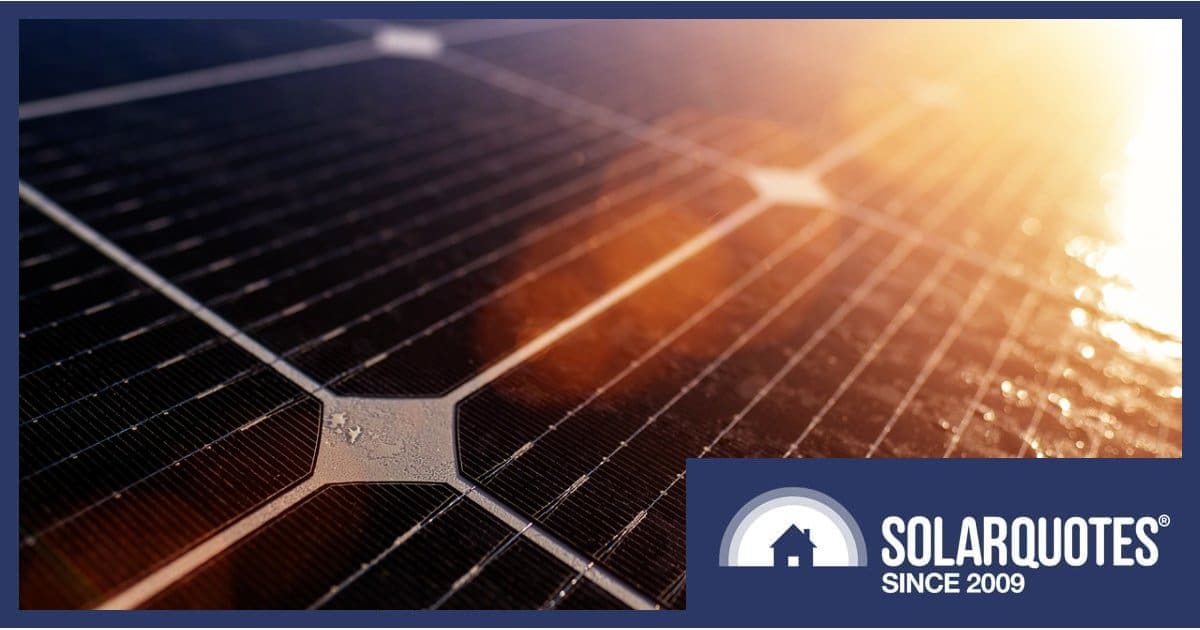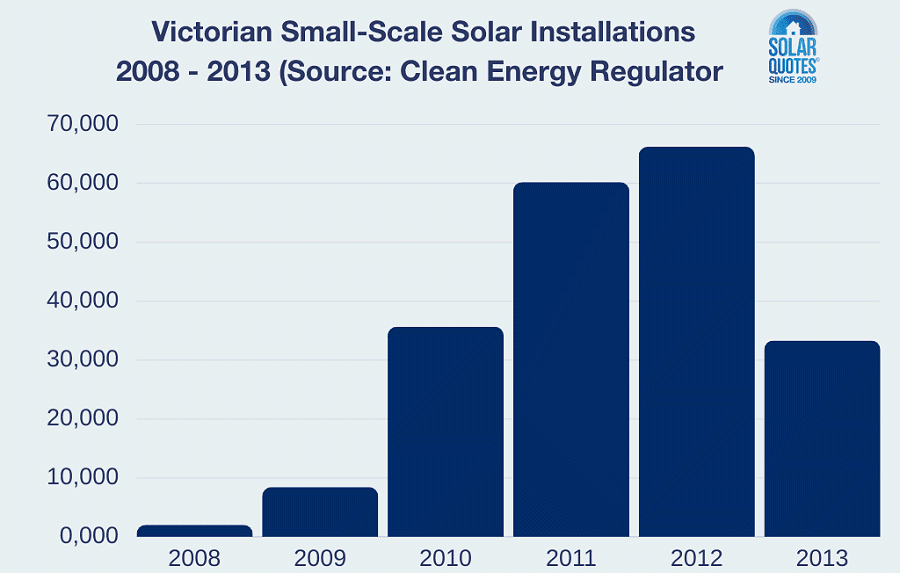
Imagine receiving a 60c feed-in tariff! Some Victorian solar owners have been getting this rate for many years, but it will be ending soon.
Back in ancient times solar-wise (2009), the Victorian state government was keen to boost rooftop solar power uptake. In November that year, it introduced an initiative offering a credit of 60 cents per kilowatt-hour for any excess solar energy exported to the mains grid.
The scheme was closed to new applicants in late 2011, but for those lucky enough to be on it, the premium feed-in tariff (PFiT) rate was set in stone for 15 years. That means it winds up on November 1 this year.
The scheme had its desired effect – the following figures indicate annual system installation tallies before, during and after the scheme was accepting applicants:
- 2008 – 2,036
- 2009 – 8,429
- 2010 – 35,676
- 2011 – 60,214
- 2012 – 66,204
- 2013 – 33,332
Note that Small-scale Technology Certificates (STCs) – which today’s Australian solar rebate is based on – can be redeemed up to 12 months after a system installation. This goes some way to explaining why the 2012 installation figure is so high (that and the Solar Credits kerfuffle at the time – another story).
According to the Victorian Department of Energy, Environment and Climate Action (page last updated in May 2023):
“More than 88,000 Victorian households, small businesses and community groups benefit from the PFIT.”
Solar owners of today not on the PFiT would drool over 60c – but bear in mind during that period what was being installed were comparatively small systems; usually around 1.5kW – 3kW capacity. And compared to the cost of larger solar power systems today, they were pretty pricey.
So, the premium feed-in tariff was a great way to accelerate payback.
While 15 years locked in at 60 cents has been a sweet deal, participants were limited as to what they could do with their systems. For example, they became ineligible to continue receiving the premium rate if they added extra solar panels, even if the overall system size remained under the scheme limit of 5 kilowatts capacity.
A Shift In Mindset
Some Victorian households still remaining on the premium feed-in tariff may get a nasty shock after November, particularly if they have very little daytime power usage but consume large amounts of mains electricity in the evenings.
In the 2024-25 financial year, the single (flat) rate minimum feed-in tariff in Victoria is just 3.3 cents per kilowatt-hour. Some electricity retailers pay more – but usually around the 5c – 6c mark currently, and that’s not going to offset much with a small system.
These households should be comparing electricity plans to see what deal suits them best, taking into account that the most appropriate plan offers a balance of competitive feed-in-tariffs, low usage tariffs and low daily charges. They should also be thinking about how they consume electricity; time-shifting appliance use to the day where possible.
Time For A New Rooftop Solar System?
Many may find a 1.5kW system simply doesn’t cut it after November. There’s some good news here. As well as the nationwide solar rebate that can knock thousands off system cost, Victorians get to double-dip with the state’s solar panel rebate. This currently offers up to $1,400 off the up-front cost of a system.
In October 2023, Solar Victoria expanded its eligibility criteria for the state incentive to households with systems over ten years old. These households may also be eligible for a hot water rebate and/or solar battery loan.
Solar Victoria, the state government agency that oversees the rebate, says:
“Solar technology has improved rapidly since 2009, and upgrading to a new, more efficient system could ensure that you won’t be hit with higher energy bills after the PFiT scheme ends.”
To get an idea of the financial benefits of installing a new, larger PV system, try the SolarQuotes solar calculator.


 RSS - Posts
RSS - Posts



Solar quote process instigated. Is there a resource for naive buyers that includes all the wuestions I should be asking?
yes: https://www.solarquotes.com.au/solar101.html
Also you can download a PDF checklist here.
We did get charged a premium tariff on consumption and I’d bet my grannies life that once it ends they’ll rip us off again with a further premium tariff to garner more money back. When it comes to govt they give with one hand and always take with the other.
If you live rurally, grab an EV.
Get dollars per kwh of effective feed in tariff when compared to petrol.
Solar power is a scam. Australian households have quite limited power usage, as most of them use gas heating in the winter. In the best-case scenario, you can get your money back within ten years if you are not moving. It is a total waste of money.
Harry, 3 points:
1. “Solar power is a scam.” Assuming you are only interested in payback – Australian solar typically takes 3-8 years to pay back, depending on your circumstances. You can check your payback here.
2. “Australian households have quite limited power usage”. The data disagrees:
3. “most of them use gas heating in the winter”. I’m assuming you are from Victoria? Australia is a big place. Around 5.1 million Australian households (approximately 48% of homes) are connected to the gas network. Gas consumption varies significantly by region. For example, 76% of homes in Victoria are connected to gas, while only 10% in Queensland are connected. Increasingly people are moving from gas to electric heating with a heat pump which is much cheaper to run because it uses less than one third the energy to harness the same amount of heat.
We are in Canberra, we have a 4.64 kWh solar system and our gas wall furnace stopped working two years ago. The gas fitter said that a replacement wouldn’t be worth it because of a decline in manufacturing quality. So we decided to rely on our reverse-cycle air-conditioning supplemented by efficient ceramic room heaters as required. Total electricity bill 2023 calender year: about $500.00. We do still have a gas hot water heater which cost us about $600.00 over the same period.
Swap that out for a heat pump at the best opportunity and save the supply charges straight away and usage each day. In reality, with your solar you’d likely be just using your own power and not have to pay a cent after installation, but even if you consumed from the grid it would be lower than gas charges. Even the top of the range Sanden cost me 6k installed after all state based incentives. At 600/year that is 10 years. If gas charges rise (as they have been), then it is likely 6-7 years for payback purely on cost. A slightly cheaper heat pump obviously reduces that time frame. You in Canberra likely have rebates for these which I in SA didn’t have access to. In my case the instantaneous gas hot water was freezing up on really cold mornings and likely needed a service call so I wrote that cost off against just getting it replaced and getting rid of gas completely. Likely at least 6 months of bill costs in repairs worth spent on something better.
Hi,
60c was the minimum, some retailers were giving 78c for sometime, even now it’s at 66.7c. Can’t complain about that, users had to shop around.
Never had a problem of being “ripped off” with high peak tariff, peak used to be 7am to 11pm (roughly), but not weekends, so a fair bit was covered by solar. Even better now, with peak 3pm to 11pm, but all days.
I did calcs before getting solar, and it worked out that at the fixed rate I paid at the time, it would cost more than if it was peak/off peak.
Unsure what to do with the solar once PFiT ends: do I install a new, much larger system? Seems there are rebates available if an old system is being replaced, so might be worth it. Mine is 1.7kW, and there’s enough room for about 50 panels if I want to. N, E, & W facing. But we’re 70, so is it worth it?
“What do you think, add a bit of value?”
b0b
I ditched my 1.5 Kw system 7 years ago, despite the fact that I’d only had it for around 4 years. Replaced it with a 6.44 system.
I’ve more than recouped both the write-off cost plus the outlay on the replacement system.
Here in QLD, and with soaring summer temperatures due to climate change impacts, my system can generate around 40+ kwh on really hot days, which is enough for me to run my reverse cycle air conditioners all day if I need to, with-out it costing me a small fortune.
Sure, I lose some FIT but the future downward trend in its value was already obvious 7 years ago.
Best financial decision I’ve ever made.
A bit of commonsense helps too. eg.. I set air-con temp at 26 degrees, which means it cuts out when the overall room temp reaches that. That’s quite comfortable, and helps avoid/reduce the rather extreme body shock you can get if you need to go outside for any reason.